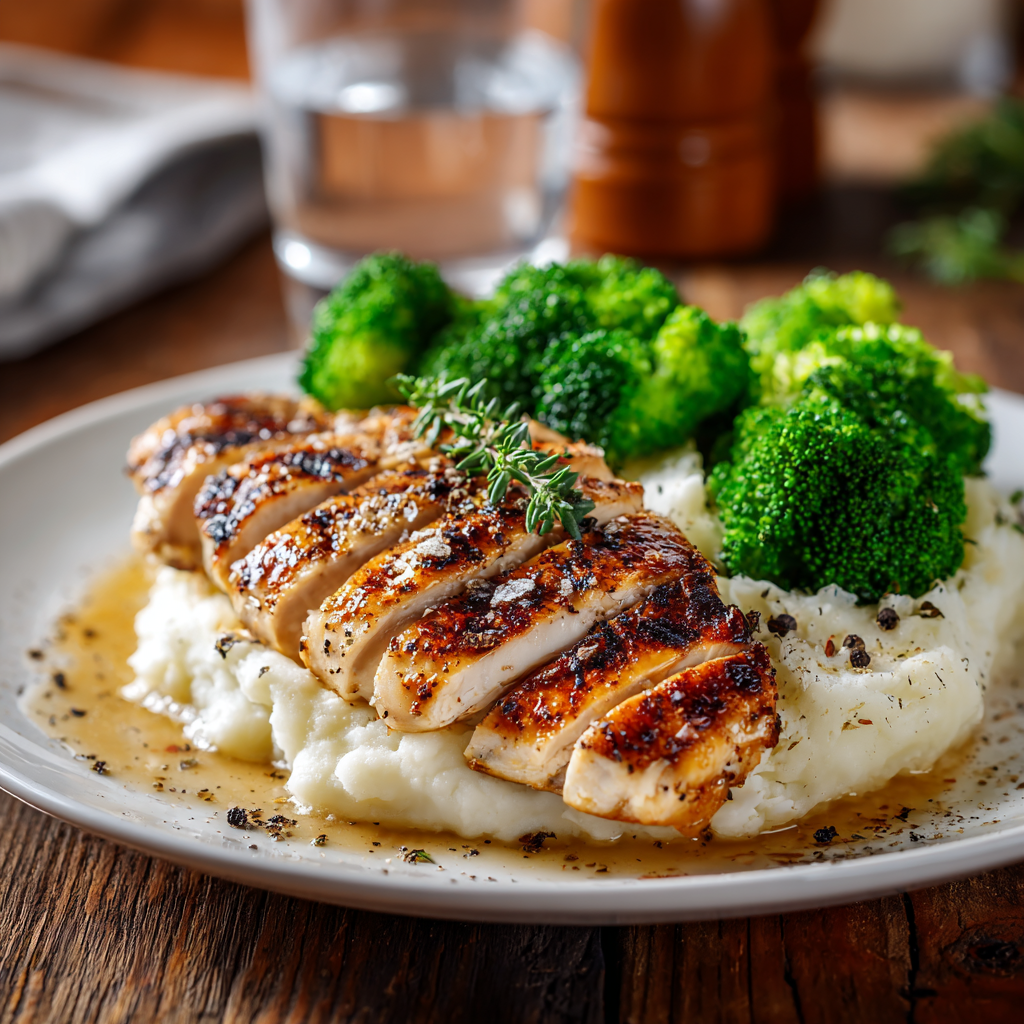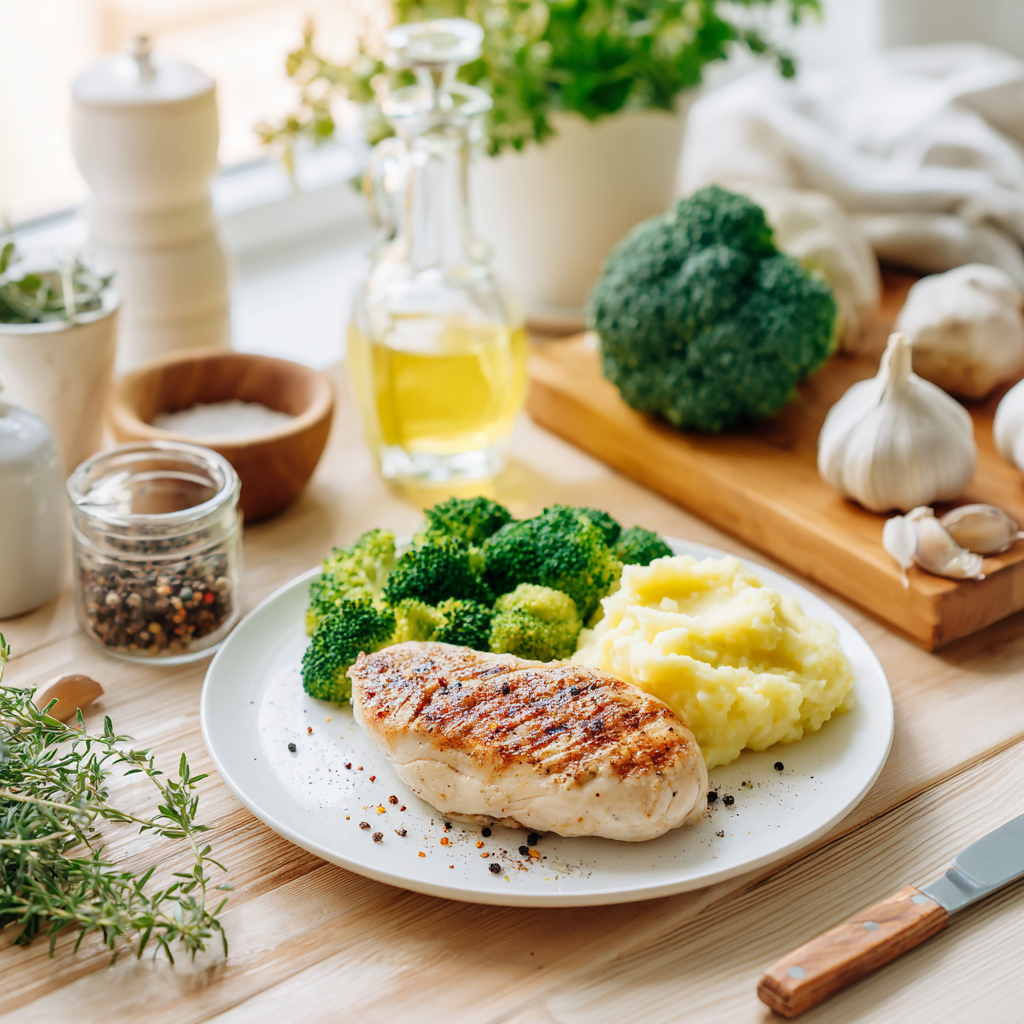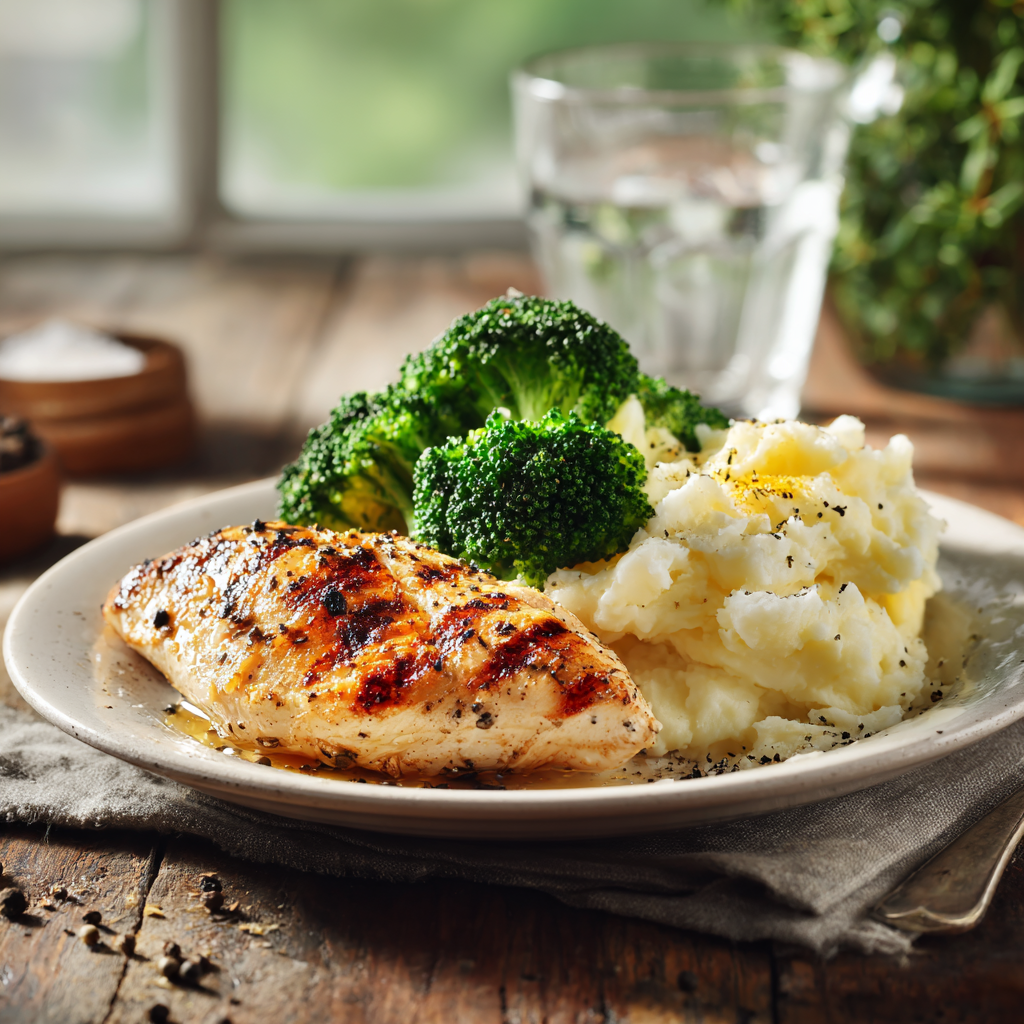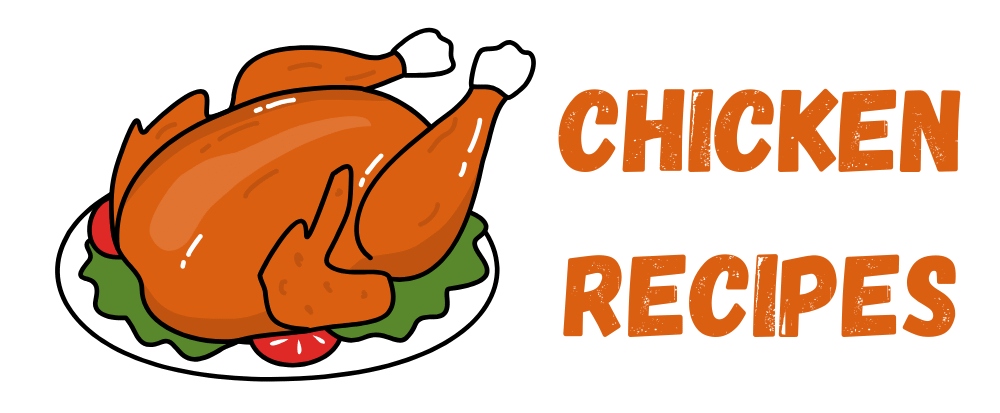
Why Low Sodium Diets Matter and How Chicken Breast Fits In
I used to think flavor came from salt. Growing up, every dish I loved had a generous sprinkle of it. But when my doctor suggested cutting back on sodium for my health, I panicked. How could I enjoy food without it? It felt impossible. Over time, though, I discovered that eating healthy doesn’t mean sacrificing taste. One of the best tools in my low-sodium toolkit? Chicken breast.
Chicken breast is a go-to ingredient for anyone looking to eat healthier. It’s lean, packed with protein, and incredibly versatile. The best part? It fits perfectly into a low-sodium diet. With easy low sodium chicken breast recipes, I learned how to make meals that are both satisfying and good for me.
Why Choose Low Sodium Chicken Breast?
When people ask, “Is chicken breast low in sodium?” the answer is yes—if you choose wisely. Fresh chicken breast is naturally low in sodium, unlike processed options like deli meats or pre-marinated cuts. A 3-ounce serving of plain, raw chicken breast contains about 60 milligrams of sodium. Compare that to processed chicken products, which can have three times as much. That makes fresh chicken breast an excellent choice for keeping your sodium intake in check.
Beyond its low sodium content, chicken breast has other nutritional benefits. Here’s why I love it:
- High in protein: Each serving helps keep you full and supports muscle repair.
- Versatile: You can grill, bake, sauté, or even shred it for salads and wraps.
- Nutrient-rich: It provides B vitamins, which help turn food into energy.
For someone like me who values simplicity and health, chicken breast is a no-brainer. But the real magic happens when you pair it with creative ways to add flavor.
How to Reduce Sodium in Chicken Breast
If you’re wondering, “How to reduce sodium in chicken breast?” start by being mindful of what you buy. Store-bought chicken often comes with added solutions or brines to enhance flavor—but those can spike the sodium levels. Here’s what works for me:
- Rinse the chicken before cooking. This simple step can remove some of the excess sodium.
- Choose fresh, unprocessed chicken instead of pre-packaged options.
- Look for labels that say “no salt added” or “air-chilled.” These are usually lower in sodium.
Once you’ve got the right chicken, it’s all about seasoning. Herbs and spices are your best friends here. They let you build layers of flavor without relying on salt. Here are a few ideas for low-sodium marinades:
- Olive oil, lemon juice, garlic powder, and black pepper
- Yogurt mixed with cumin, paprika, and fresh cilantro
- Balsamic vinegar, rosemary, and a touch of honey
These combinations work wonders. For example, one of my favorite easy low sodium chicken breast recipes involves rubbing the chicken with smoked paprika and thyme. The spices create a rich, smoky flavor that feels indulgent but stays healthy.
Another tip: use citrus zest. Grating a bit of orange or lime peel over cooked chicken adds brightness without any extra sodium. Trust me—it’s a game changer (not literally, but figuratively).
What Is the Healthiest Way to Cook Chicken Breasts?
Cooking methods matter too. Some techniques preserve nutrients better than others. Here’s what I’ve found most effective:
- Baking: Keeps the chicken moist and requires minimal oil.
- Grilling: Adds a charred flavor while keeping things light.
- Poaching: Ideal for shredding chicken for salads or soups.
Avoid frying if possible. While crispy skin might sound tempting, frying adds unnecessary fat and calories. Instead, try broiling for a similar crunch without the guilt.
One of my favorite methods is baking chicken with a mix of herbs. Simply toss chopped chicken with olive oil, dried oregano, and cracked pepper. Bake at 400°F for 25 minutes, and you’ve got a meal that’s quick, flavorful, and healthy.
Adding Flavor Without Salt
“How can I add flavor to chicken without salt?” is a question I hear often. My advice: get creative with textures and aromatics. Here’s how:
- Top baked chicken with a salsa made from diced tomatoes, onions, and jalapeños.
- Serve it alongside roasted vegetables seasoned with turmeric and ginger.
- Make a simple pan sauce using wine, mustard, and fresh herbs.
Experimentation is key. Once I started playing around with different seasonings, I realized how much depth herbs and spices could bring. For instance, pairing chicken with a rub of chili powder and coriander gives it a bold kick that doesn’t rely on salt.
The journey to finding easy low sodium chicken breast recipes taught me something valuable: flavor isn’t just about salt. It’s about balance, creativity, and knowing how to work with what you’ve got. Whether you’re new to low-sodium cooking or a seasoned pro, these tips will help you make delicious meals without compromising your health.

Flavorful Alternatives: Adding Taste Without Salt
You know, I used to think that skipping salt meant saying goodbye to flavor. Boy, was I wrong. Once I started experimenting with other ways to season chicken breast, I realized just how much untapped potential there is in spices, herbs, and even citrus. Here’s the thing—adding flavor without salt isn’t just doable; it can actually be fun. And trust me, your taste buds will thank you.
Let’s talk about spices first because they’re like the unsung heroes of the kitchen. Have you ever tried a mix of smoked paprika and cumin? It’s bold, smoky, and gives chicken an almost meaty depth. Or what about turmeric? This golden spice doesn’t just add color—it’s packed with anti-inflammatory properties too. Funny enough, I discovered turmeric while trying to mimic some of my favorite curry dishes. Now, it’s a staple in my spice rack.
Herbs are another game changer. Fresh herbs like basil, cilantro, or parsley bring a burst of brightness, while dried ones like rosemary or thyme offer a more earthy vibe. One of my go-to combos is lemon pepper seasoning. Just zest a lemon over the chicken, sprinkle some cracked black pepper, and let it sit for 10 minutes before cooking. The result? A zesty, aromatic dish that feels indulgent but stays low sodium.
By the way, don’t sleep on citrus. A squeeze of lime or orange juice can transform plain chicken into something vibrant and exciting. I once made Cajun stuffed chicken breast recipes and added a splash of orange juice to the filling—it was a hit! Citrus not only enhances flavor but also helps tenderize the meat slightly, which is always a bonus.
Here’s a little trick I swear by: make a rub using garlic powder, onion powder, and a pinch of chili flakes. Garlic and onion powders are sodium-free alternatives to their salt-laden counterparts, and they pack a serious punch. I’ve served this combo to friends who couldn’t believe it didn’t have salt. Oh, and if you’re feeling adventurous, toss in some dried oregano for a Mediterranean twist.
Health benefits? Absolutely. Many of these flavor boosters come with perks beyond taste. For instance, ginger adds a warm kick and aids digestion, while cinnamon (yes, cinnamon!) can balance blood sugar levels. Even chili peppers, when used sparingly, can rev up your metabolism. So, not only are you avoiding excess sodium, but you’re also sneaking in some extra goodness.
The Healthiest Ways to Cook Chicken Breasts
Now, let’s shift gears and chat about cooking methods. Because here’s the deal—even the best-seasoned chicken won’t shine if it’s cooked poorly. If you’ve ever wondered, “What is the healthiest way to cook chicken breasts?” you’re in luck. I’ve tested several techniques, and I’m here to share the winners.
Baking is hands down one of my favorites. It’s simple, hands-off, and keeps the chicken juicy without needing tons of oil. Try this: coat your chicken with a mix of olive oil, garlic powder, and dried thyme, then bake at 375°F for 25-30 minutes. The aroma alone will have everyone rushing to the table. Plus, baking lets you prep sides like roasted veggies at the same time, which is perfect for busy weeknights.
Grilling, on the other hand, gives you those beautiful char marks and a smoky flavor that’s hard to beat. I love grilling during summer barbecues, especially when paired with a fresh salsa. Pro tip: brush the chicken with a tiny bit of olive oil before placing it on the grill to prevent sticking. And if you’re not a fan of outdoor grills, indoor grill pans work just as well.
Steaming might sound boring, but hear me out. It’s one of the gentlest methods for cooking chicken, preserving its natural moisture and nutrients. I often steam chicken breasts when I plan to shred them for salads or sandwiches. It’s quick, fuss-free, and pairs beautifully with flavorful sauces. Speaking of sauces, why not whip up a mustard-based one using Dijon mustard, a splash of apple cider vinegar, and chopped dill?
Poaching is another underrated technique. You gently simmer the chicken in liquid—like broth, water, or even coconut milk—and it comes out ridiculously tender. I recently poached chicken in a mix of vegetable broth and lemongrass for a Thai-inspired dish. Paired with some steamed broccoli, it was light yet satisfying.
One method I’d advise steering clear of? Frying. Sure, crispy fried chicken sounds tempting, but it adds unnecessary calories and fat. Instead, try broiling for a similar crunch without the guilt. Just place the chicken under the broiler for a few minutes until the top turns golden brown.
If you’re looking for inspiration, check out stuffed chicken breast recipes wrapped in bacon. While bacon isn’t exactly low-sodium, you can use turkey bacon as a healthier alternative. The stuffing options are endless—think spinach, sun-dried tomatoes, or even quinoa.
Baked Herb-Crusted Chicken Recipe
Alright, let’s get practical. Here’s a quick recipe that ties everything together: baked herb-crusted chicken. It’s one of those easy low sodium chicken breast recipes that feels fancy but takes minimal effort. Perfect for impressing guests or just treating yourself on a Tuesday night.
Start by preheating your oven to 400°F. Grab two boneless, skinless chicken breasts and pat them dry with paper towels—that’s key for getting a good sear later. In a small bowl, mix breadcrumbs (use whole wheat for extra fiber), dried parsley, garlic powder, and a dash of black pepper. Drizzle a bit of olive oil over the chicken, then press each piece into the breadcrumb mixture until fully coated.
Place the crusted chicken on a baking sheet lined with parchment paper. Pop it in the oven and bake for 20-25 minutes, or until the internal temperature reaches 165°F. While it bakes, whip up a side of roasted veggies tossed with a sprinkle of rosemary. Trust me, the combo is divine.
For an extra layer of flavor, serve the chicken with a dollop of Greek yogurt mixed with lemon zest and chopped chives. It’s creamy, tangy, and complements the crispy crust perfectly. If you’re craving something cheesy, take a peek at stuffed chicken breast recipes with broccoli and cheese. They’re a great way to sneak in some greens while keeping things delicious.
Oh, and if you’re a slow cooker enthusiast, I highly recommend checking out slow cooker chicken breast recipes weight watchers. They’re lifesavers for meal prep and keep the chicken insanely moist. Just toss in your favorite seasonings, set it, and forget it.
There you have it—a guide to making chicken breast exciting, healthy, and low in sodium. With these tips and recipes, you’ll never look at plain chicken the same way again. Happy cooking!

More Easy Low Sodium Chicken Breast Recipes
Alright, let’s keep the momentum going with some fresh ideas. You’ve got the basics down, but what about when you’re craving something a little different? Here’s where I like to get creative. Whether it’s a quick weeknight dinner or a meal-prep masterpiece, these recipes will keep your low-sodium journey exciting.
One of my all-time favorites is citrus-infused grilled chicken. It’s summery, refreshing, and couldn’t be easier. Start by marinating chicken breasts in a mix of fresh orange juice, lime zest, minced garlic, and a splash of apple cider vinegar. Let it sit for at least 30 minutes—longer if you have time. Then, throw it on the grill until those beautiful char marks appear. Serve it with a side of quinoa salad tossed with parsley and cucumber. The citrus adds such a bright note that you won’t even miss the salt.
Another go-to is stir-fried chicken with vegetables. This one’s perfect for busy nights because it’s ready in under 20 minutes. Slice your chicken into thin strips and toss them in a bit of cornstarch—it helps create a light coating without adding sodium. Heat up some sesame oil in a pan, throw in the chicken, and once it’s cooked through, add veggies like bell peppers, snap peas, and carrots. Finish with a drizzle of low-sodium soy sauce (yes, they make it!) and a sprinkle of red pepper flakes for a little kick. I swear, this dish always feels like a hug in a bowl.
Here’s the thing: variety keeps things interesting. If you’re looking for something cozy, try making a chicken and vegetable bake. Toss chopped chicken with zucchini, cherry tomatoes, and red onion. Sprinkle dried basil and oregano over the top, then bake everything together at 400°F for about 25 minutes. The juices from the veggies mingle with the chicken, creating a sauce that’s naturally flavorful. Plus, it’s an entire meal in one dish—less cleanup is always a win.
By the way, don’t forget about slow cooker magic. Have you ever made a slow-cooked chicken stew? Throw in chicken breasts, diced potatoes, carrots, and celery. Add a splash of white wine and a bay leaf, then let it simmer all day. When you come home, the house smells amazing, and dinner’s practically ready. Pro tip: shred the chicken right in the pot for a hearty, comforting texture.
If you’re feeling fancy, why not try herb-crusted stuffed chicken breast recipes? These are surprisingly simple but look impressive. Cut a pocket into the chicken, stuff it with spinach and roasted red peppers, then coat the outside with a mix of breadcrumbs, thyme, and paprika. Bake until golden, and voilà—you’ve got yourself a restaurant-worthy dish. Just be careful not to overstuff; otherwise, you’ll end up with filling everywhere (trust me, I’ve been there).
Funny enough, I discovered low sodium chicken breast recipes while experimenting with global flavors. For instance, Indian-inspired chicken curry is a game changer. Use coconut milk, turmeric, and garam masala to create a rich, creamy sauce. Serve it over brown rice or with naan bread for a satisfying meal that’s still healthy. Who says low sodium has to be boring?
Tips for Meal Prep Success
Now, let’s talk about making life easier. Meal prepping isn’t just for gym enthusiasts—it’s for anyone who wants to save time and stay on track with their health goals. And guess what? Chicken breast is the ultimate meal prep superstar.
First off, batch cooking is your best friend. Cook a big batch of chicken at the start of the week, and you’ll have protein ready to go for salads, wraps, or grain bowls. I like to bake several chicken breasts at once, seasoning them differently so I don’t get bored. One might be coated in chili powder and cumin, while another gets a rub of rosemary and garlic powder. Variety keeps things fun.
Storage matters too. Invest in good-quality containers that seal tightly. I prefer glass ones because they’re microwave-safe and don’t retain odors. Store each portion separately, and label them with the date—I’ve learned the hard way that forgetting how long something’s been in the fridge can lead to sad, wasted food.
Reheating is where most people go wrong. Microwaving can dry out chicken faster than you can say “dinner.” Instead, reheat slices or chunks in a skillet with a tiny bit of water or broth. It keeps the chicken moist and prevents it from turning rubbery. Alternatively, pop it in the oven at 300°F for 10 minutes. Yes, it takes a bit longer, but the texture is worth it.
Oh, and here’s a pro tip: freeze individual portions if you know you won’t eat them within a few days. Wrap each piece tightly in plastic wrap, then place it in a freezer bag. When you’re ready to use it, thaw overnight in the fridge. This method works wonders for soups or casseroles where you need pre-cooked chicken.
Meal prepping doesn’t have to feel like a chore. Put on your favorite playlist or podcast, pour yourself a drink (mocktail or otherwise), and turn it into a little self-care session. Before you know it, you’ll have a fridge full of delicious, easy low sodium chicken breast recipes waiting for you.
Frequently Asked Questions (FAQ)
How can I add flavor to chicken without salt?
Use herbs, spices, and aromatics like garlic, ginger, and citrus. Marinades with olive oil, lemon juice, and herbs work wonders. Try combinations like smoked paprika and thyme or turmeric and black pepper for bold flavors. Fresh salsas and sauces also add depth without sodium.
How to reduce sodium in chicken breast?
Opt for fresh, unprocessed chicken and avoid pre-marinated options. Rinsing the chicken before cooking can help remove excess sodium. Look for labels like “air-chilled” or “no salt added.” Season with herbs and spices instead of relying on salt-based seasonings.
What is the healthiest way to cook chicken breasts?
Baking, grilling, and steaming are among the healthiest methods. They require minimal oil and preserve nutrients. Avoid frying, as it adds unnecessary fat. Broiling is a great alternative if you want a crispy texture without deep frying.
Is chicken breast low in sodium?
Yes, fresh chicken breast is naturally low in sodium, containing about 60 milligrams per 3-ounce serving. However, processed versions like deli meats or brined cuts can be much higher. Always check labels and choose unprocessed options.
Can I use frozen chicken for low sodium recipes?
Absolutely! Just make sure to thaw it properly in the fridge to avoid uneven cooking. Frozen chicken can sometimes retain more moisture, which is great for dishes like stews or casseroles. Avoid using salt-laden frozen meals, though.
What are some low sodium marinades for chicken?
Try olive oil mixed with lemon juice and garlic powder, yogurt blended with cumin and cilantro, or balsamic vinegar paired with rosemary. These combos add tons of flavor without relying on salt.
How do I prevent chicken from drying out during meal prep?
Cook the chicken gently—avoid high heat. Baking at lower temperatures or poaching in broth keeps it moist. Let the chicken rest for a few minutes after cooking to redistribute juices.
Are there low sodium alternatives to soy sauce?
Yes, many brands offer low sodium soy sauce. You can also use coconut aminos, which have a similar umami flavor but less sodium. Another option is to dilute regular soy sauce with water or broth.
Can I freeze cooked chicken for later use?
Definitely! Freeze cooked chicken in airtight containers or freezer bags. Thaw it in the fridge overnight before reheating. It’s perfect for soups, salads, or sandwiches.
What sides pair well with low sodium chicken?
Roasted vegetables, quinoa, brown rice, and fresh salads are excellent choices. They complement the chicken without adding extra sodium. Experiment with herbs and citrus to enhance their natural flavors.
Final Thoughts
You know, cooking low sodium chicken breast recipes has taught me that restrictions can actually spark creativity. There’s something incredibly satisfying about whipping up a flavorful meal that aligns with your health goals. So, don’t be afraid to experiment—try new spices, techniques, or cuisines. Share your creations with friends or family, and maybe inspire someone else to join you on this flavorful journey.

Easy Low Sodium Chicken Breast Recipes
Ingredients
Equipment
Method
- Preheat your oven to 400°F.
- Pat the chicken breasts dry with paper towels.
- In a small bowl, mix the breadcrumbs, dried parsley, garlic powder, and black pepper.
- Drizzle olive oil over the chicken breasts.
- Press each chicken breast into the breadcrumb mixture until fully coated.
- Place the crusted chicken on a baking sheet lined with parchment paper.
- Bake for 20-25 minutes, or until the internal temperature reaches 165°F.
- Serve with a dollop of Greek yogurt mixed with lemon zest and chopped chives, if desired.
